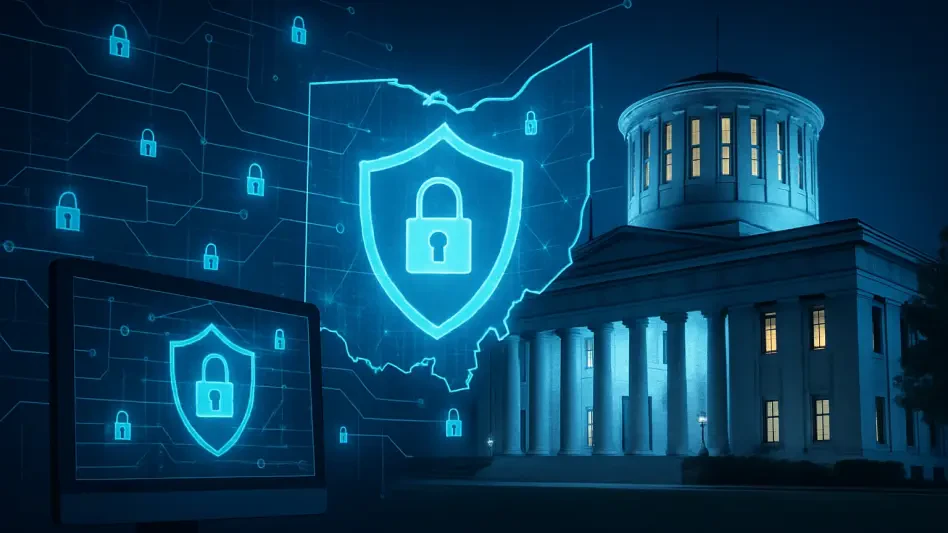In an era where digital threats loom larger than ever, Ohio has taken a decisive stand with its newly enacted cybersecurity regulations for local governments, aiming to shield sensitive data and maintain the seamless operation of vital municipal services. Embedded within the state budget, these rules come as a response to the escalating wave of cyber-attacks, including ransomware incidents that have wreaked havoc on communities statewide. Digitized records—ranging from court documents to utility payments—are prime targets for cybercriminals, placing local administrations at the forefront of a battle against both sophisticated nation-state actors and opportunistic hackers. The urgency of this issue cannot be overstated, as recent disruptions in various Ohio towns have exposed the fragility of unprotected systems. This legislation seeks to fortify municipalities against such vulnerabilities, setting a precedent for proactive defense in the digital age. As local governments brace for the impact, the implications of these mandates promise to reshape the landscape of public administration across the state.
Decoding the Framework of Ohio’s Cybersecurity Legislation
Core Requirements and Timelines for Compliance
Ohio’s latest cybersecurity regulations introduce a robust set of requirements designed to elevate the security posture of local governments. At the heart of the law is the mandate for municipalities to report any cyber incidents to the Ohio Department of Public Safety and the Auditor’s Office, ensuring swift state-level awareness and response. Additionally, comprehensive cybersecurity programs must be established, complete with employee training to mitigate human error—a common entry point for attacks. The compliance deadlines are staggered to accommodate varying capacities: counties and cities are required to meet these standards by January 1, while smaller local entities have until July 1. This phased approach acknowledges the diverse resources available across Ohio’s municipalities, yet it underscores the urgency for all to act promptly. The goal is clear—create a unified defense mechanism that leaves no community exposed to the growing sophistication of digital threats.
Beyond the immediate mandates, the legislation emphasizes a proactive stance on cybersecurity through structured planning and accountability. Local governments must not only implement technical safeguards but also document and formalize their strategies to ensure consistency and preparedness. This includes regular updates to security protocols to keep pace with evolving threats. The state’s role in overseeing compliance adds a layer of scrutiny, pushing municipalities to prioritize these efforts despite potential budgetary or staffing constraints. For many, this means a cultural shift toward viewing cybersecurity as an integral part of governance rather than an optional add-on. As deadlines approach, the pressure to align with these standards will test the resilience and adaptability of local administrations, highlighting the critical need for state support in the form of guidance and resources to bridge any gaps in capability.
Balancing Transparency with Protective Measures
One of the standout provisions of the new law focuses on transparency in handling ransomware incidents, requiring local governments to pass public resolutions if they decide to pay demands. This measure aims to prevent secretive dealings that could embolden cybercriminals by showcasing a pattern of compliance with ransom requests. By making such decisions public, the legislation fosters accountability and encourages municipalities to explore alternative solutions, such as enhanced backups or incident response plans, before resorting to payment. This approach not only protects public funds but also builds trust with residents who expect openness in how their local leaders manage crises. The emphasis on transparency reflects a broader commitment to ethical governance in the face of digital extortion, setting Ohio apart as a state prioritizing both security and public confidence.
Equally significant is the law’s provision to exempt certain cybersecurity records from public disclosure, a move designed to safeguard defensive strategies from falling into the wrong hands. Cybercriminals often exploit publicly available information to identify weaknesses in systems, and this exemption ensures that detailed security plans or vulnerability assessments remain confidential. This protective measure strikes a balance between the public’s right to know and the imperative to shield critical infrastructure from reconnaissance by threat actors. It demonstrates a nuanced understanding of the cybersecurity landscape, where information itself can be weaponized. As local governments adapt to this dual focus on openness and protection, the challenge lies in maintaining resident trust while implementing discreet yet effective security protocols to thwart potential attacks.
Assessing the Practical Effects on Municipalities
Lessons from Recent Digital Threats
The urgency behind Ohio’s cybersecurity regulations is vividly illustrated by recent cyber incidents that have struck communities across the state. Towns like Huber Heights, Middletown, and West Chester Township have faced significant disruptions due to ransomware and data breaches, with some declaring states of emergency to manage the fallout. These attacks have paralyzed essential services, from utility billing to public safety systems, exposing the cascading effects of inadequate digital defenses. Residents have borne the brunt of delayed services and compromised personal information, amplifying the call for stronger safeguards. Such real-world examples serve as a stark reminder that cyber threats are not abstract risks but tangible crises that can undermine the fabric of local governance, making the new regulations not just timely but essential.
Beyond the immediate disruptions, these incidents have eroded public trust in municipal systems, posing long-term challenges for local leaders. When sensitive data is exposed or services grind to a halt, residents question the reliability of their government’s infrastructure. The financial costs of recovery—often running into millions—further strain budgets already stretched thin. Ohio’s legislation aims to curb such fallout by mandating proactive measures that prioritize prevention over reaction. By learning from these past breaches, municipalities can better anticipate vulnerabilities and fortify their defenses, ensuring that future attacks are met with resilience rather than chaos. The state’s push for standardized cybersecurity programs offers a blueprint for rebuilding trust and operational stability, addressing both the technical and societal impacts of digital threats.
Adapting to a New Era of Accountability
Local governments across Ohio are stepping up to the challenge posed by the new cybersecurity rules, with many demonstrating a readiness to comply based on existing practices. Cities such as Kettering and Troy have reported that their current frameworks already align with many of the state’s requirements, needing only minor tweaks to meet formal standards. Larger entities like Montgomery County emphasize a long-standing commitment to data protection, viewing the legislation as a reinforcement of their ongoing efforts. This preparedness reflects a growing recognition among municipal leaders that cybersecurity is a core component of public service in the digital age. The state’s structured deadlines provide a clear roadmap for these governments to refine their approaches, ensuring they remain ahead of emerging threats while maintaining operational continuity for their communities.
However, readiness does not equate to complacency, as even well-prepared municipalities face the task of formalizing policies and enhancing transparency mechanisms. For some, this involves integrating incident reporting into standard procedures and ensuring public accountability in ransomware scenarios. State guidance plays a pivotal role here, offering resources and best practices to streamline compliance. The proactive stance of these local governments highlights a broader shift toward viewing cybersecurity as a shared responsibility, one that requires collaboration between state and local levels. As these entities refine their strategies, the focus remains on building systems that not only protect data but also uphold public trust. This adaptation marks a significant step toward a more secure municipal landscape, where digital resilience becomes as fundamental as any other public service.
Navigating the Path to Full Implementation
For other municipalities like Fairborn and Xenia, the journey to compliance involves more substantial updates to their cybersecurity frameworks, reflecting the diverse capacities across Ohio’s local governments. These communities are actively revamping their policies to align with state mandates, focusing on consolidating best practices into cohesive, actionable plans. This process often requires significant investment in technology and training, as well as a cultural shift to prioritize digital security at all levels of operation. The staggered deadlines provide some breathing room, but the urgency to act remains high given the persistent threat of cyber-attacks. State support, through guidance and potential funding, is seen as a critical enabler in helping these governments bridge resource gaps and meet the required standards without compromising other essential services.
The challenges of formalization extend beyond technical upgrades to include procedural adjustments that ensure long-term sustainability. Municipalities must establish clear protocols for incident response, regularly update their defenses, and maintain transparency with residents about cyber risks and responses. This comprehensive approach demands coordination across departments, often straining limited staff and budgets. Yet, the shared understanding among local leaders is that cybersecurity is no longer optional but a fundamental duty. As these governments work toward full implementation, the focus is on creating adaptable systems that can evolve with emerging threats. The state’s role in fostering this transition cannot be understated, as ongoing collaboration will determine how effectively Ohio’s municipalities can protect their digital infrastructure while continuing to serve their communities with confidence.
Reflecting on a Safer Digital Landscape
Looking back, Ohio’s rollout of new cybersecurity regulations stood as a defining moment for local governments, fortifying them against the relentless tide of digital threats. The mandates, with their emphasis on incident reporting, transparency in ransomware decisions, and structured compliance timelines, provided a robust framework that reshaped municipal operations. Communities across the state, from bustling cities to smaller towns, adapted with varying degrees of readiness, yet all moved toward a common goal of safeguarding resident data and essential services. The real-world impacts of past cyber incidents served as a catalyst, driving home the necessity of these measures. Moving forward, the focus should center on sustained collaboration between state and local entities to refine these defenses, ensuring resources and expertise are accessible to all. As cyber threats continue to evolve, regular policy updates and public education on digital safety will be vital next steps in maintaining this hard-earned resilience.








